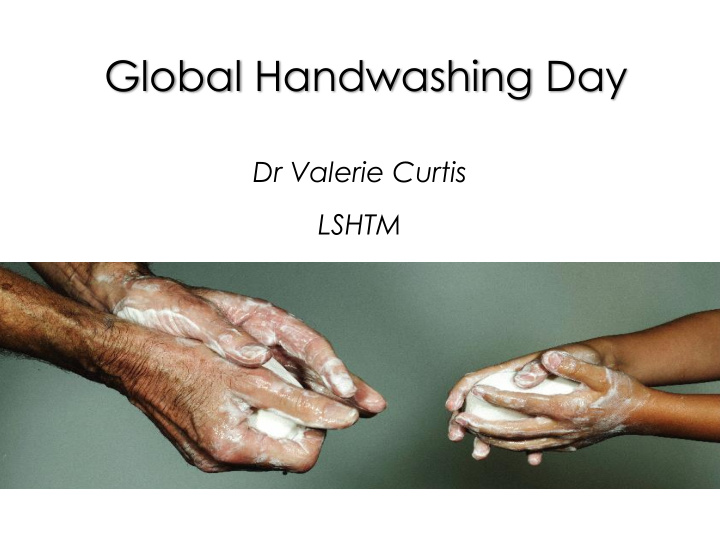



Global Handwashing Day Dr Valerie Curtis LSHTM
Why HWWS? Some 23-40% reduction in diarrhoea risk • (Freeman et al 2014) Global disease burden 300 000-600 000 • lives p.a. China: not HWWS costs $10bn, 10x ROI • India: not HWWS costs $30bn, 20x ROI • Prevention of pandemics and AMR •
The Parable No messaging – no words! • No knowledge – about emotion, reward • Universal • No death, disease or doctors • Strong levers to unlock a routine • Surprise, Revaluation, Performance •
Change in safe food behaviour 100 % of mother practicing targeted 88 Before (n=120) After (119) 86 90 77 80 67 67 70 55 60 50 43 behaviour 40 24 30 20 5 5 10 3 3 1 1 0 Source: Om Gautam, 2014
Behaviour Centred Design A ssess + B uild C reate Behaviour Setting Health Intervention Environment Behaviour Brain D eliver E valuate
A B C D E Assess Build Create Deliver Evaluate Behaviour Centred Design
www.superamma.org
SuperAmma Results 40% handwashing at target events 37% 35% 29% intervention in first 30% 29% half of villages 25% 20% 19% 15% 10% intervention in control villages 4% 6% 5% 2% 0% 1% baseline 1st follow up 2nd follow up 3rd follow up Source: Biran et al Lancet GH 2013
View Intervention Control HWWs is good manners 84% 21% HWWS protects children 63% 2% HWWS leads to success 30% 0% in life Everybody around here 35% 8% WHWS Source: Greenland et al 2015
40% handwashing at target events 37% 35% 29% intervention in first 30% 29% half of villages 25% 20% 19% 15% 10% intervention in control villages 4% 6% 5% 2% 0% 1% baseline 1st follow up 2nd follow up 3rd follow up (6 weeks) (6 months) (12 months)
Behaviour Centred Design A ssess + B uild C reate Behaviour Setting Health Intervention Environment Behaviour Brain Surprise Revaluation Performance D eliver E valuate
Takeaways Surprise, revaluation performance • 10% of effort and investment on design • of intervention Private sector lessons: scale, cost, refresh • Use professionals • Long term policy and capacity •
Thanks Hygiene Centre @ LSHTM: Bob Aunger, • Adam Biran, Val Curtis, Katie Greenland, Jessie deWitt Huberts, Wolf Schmidt, Sian White, Om Gautam, Gaby Judah Funders: Wellcome, ESRC, DFID, SHARE, • World Bank, Unicef, Gates, GAIN, WaterAid, WSSCC, Unilever, KCC, GoJo
BCD Materials 1. WWW.EHG/BehaviourCentredDesign for manual and papers : Aunger and Curtis, Kinds of Behavior, Aunger and Curtis The Anatomy of Motivation 2. Ghana handwashing ad (1990s) https://www.youtube.com/watch?v=w2qRcMTstzc 3. Rural Indian handwashing campaign (2013) http://www.superamma.org 4. Zambian multiple behaviour change campaign (2014) EBF: https://www.youtube.com/watch?v=zHTwlhQdjiw ORS: https://www.youtube.com/watch?v=w45PtrHUEdg Handwashing: https://www.youtube.com/watch?v=l3jcDuU_5sc
Recommend
More recommend